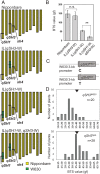A stepwise route to domesticate rice by controlling seed shattering and panicle shape
- PMID: 35733263
- PMCID: PMC9245615
- DOI: 10.1073/pnas.2121692119
A stepwise route to domesticate rice by controlling seed shattering and panicle shape
Abstract
Asian rice (Oryza sativa L.) is consumed by more than half of the world's population. Despite its global importance, the process of early rice domestication remains unclear. During domestication, wild rice (Oryza rufipogon Griff.) acquired non-seed-shattering behavior, allowing humans to increase grain yield. Previous studies argued that a reduction in seed shattering triggered by the sh4 mutation led to increased yield during rice domestication, but our experiments using wild introgression lines show that the domesticated sh4 allele alone is insufficient for shattering loss in O. rufipogon. The interruption of abscission layer formation requires both sh4 and qSH3 mutations, demonstrating that the selection of shattering loss in wild rice was not as simple as previously suggested. Here we identified a causal single-nucleotide polymorphism at qSH3 within the seed-shattering gene OsSh1, which is conserved in indica and japonica subspecies but absent in the circum-aus group of rice. Through harvest experiments, we further demonstrated that seed shattering alone did not significantly impact yield; rather, yield increases were observed with closed panicle formation controlled by SPR3 and further augmented by nonshattering, conferred by integration of sh4 and qSH3 alleles. Complementary manipulation of panicle shape and seed shattering results in a mechanically stable panicle structure. We propose a stepwise route for the earliest phase of rice domestication, wherein selection of visible SPR3-controlled closed panicle morphology was instrumental in the sequential recruitment of sh4 and qSH3, which together led to the loss of shattering.
Keywords: Oryza rufipogon; Oryza sativa; closed panicle; domestication; seed shattering.
Conflict of interest statement
The authors declare no competing interest.
Figures





Similar articles
-
Detection of novel loci involved in non-seed-shattering behaviour of an indica rice cultivar, Oryza sativa IR36.Mol Genet Genomics. 2023 Jul;298(4):943-953. doi: 10.1007/s00438-023-02027-z. Epub 2023 May 17. Mol Genet Genomics. 2023. PMID: 37195447 Free PMC article.
-
Estimation of loci involved in non-shattering of seeds in early rice domestication.Genetica. 2017 Apr;145(2):201-207. doi: 10.1007/s10709-017-9958-x. Epub 2017 Feb 25. Genetica. 2017. PMID: 28238052
-
Inhibition of abscission layer formation by an interaction of two seed-shattering loci, sh4 and qSH3, in rice.Genes Genet Syst. 2015;90(1):1-9. doi: 10.1266/ggs.90.1. Genes Genet Syst. 2015. PMID: 26119661
-
Advances in Rice Seed Shattering.Int J Mol Sci. 2023 May 17;24(10):8889. doi: 10.3390/ijms24108889. Int J Mol Sci. 2023. PMID: 37240235 Free PMC article. Review.
-
The complex history of the domestication of rice.Ann Bot. 2007 Nov;100(5):951-7. doi: 10.1093/aob/mcm128. Epub 2007 Jul 6. Ann Bot. 2007. PMID: 17617555 Free PMC article. Review.
Cited by
-
Detection of novel loci involved in non-seed-shattering behaviour of an indica rice cultivar, Oryza sativa IR36.Mol Genet Genomics. 2023 Jul;298(4):943-953. doi: 10.1007/s00438-023-02027-z. Epub 2023 May 17. Mol Genet Genomics. 2023. PMID: 37195447 Free PMC article.
-
Population structure and genetic differentiation analyses reveal high level of diversity and allelic richness in crop wild relatives of AA genome species of rice (Oryza sativa L.) in India.J Appl Genet. 2023 Dec;64(4):645-666. doi: 10.1007/s13353-023-00787-3. Epub 2023 Sep 25. J Appl Genet. 2023. PMID: 37743422
-
Transcriptome and metabolome analysis of senescent rice (Oryza sativa L.) seeds: insights into the mechanism of germination vigor and seedling morphogenesis.BMC Plant Biol. 2025 May 6;25(1):591. doi: 10.1186/s12870-025-06458-1. BMC Plant Biol. 2025. PMID: 40325369 Free PMC article.
-
Genetic dissection of a reduced seed-shattering trait acquired in rice domestication.Breed Sci. 2024 Sep;74(4):285-294. doi: 10.1270/jsbbs.23080. Epub 2024 Aug 30. Breed Sci. 2024. PMID: 39872329 Free PMC article.
-
Meta-analysis of QTLs and candidate genes associated with seed germination in rice (Oryza sativa L.).Physiol Mol Biol Plants. 2022 Aug;28(8):1587-1605. doi: 10.1007/s12298-022-01232-1. Epub 2022 Sep 21. Physiol Mol Biol Plants. 2022. PMID: 36389095 Free PMC article.
References
-
- Harlan J. R., de Wet J. M. J., Price E. G., Comparative evolution of cereals. Evolution 27, 311–325 (1973). - PubMed
-
- Doebley J. F., Gaut B. S., Smith B. D., The molecular genetics of crop domestication. Cell 127, 1309–1321 (2006). - PubMed
-
- Fuller D. Q., et al. , The domestication process and domestication rate in rice: Spikelet bases from the Lower Yangtze. Science 323, 1607–1610 (2009). - PubMed
-
- Li C., Zhou A., Sang T., Rice domestication by reducing shattering. Science 311, 1936–1939 (2006). - PubMed
-
- Konishi S., et al. , An SNP caused loss of seed shattering during rice domestication. Science 312, 1392–1396 (2006). - PubMed
Publication types
MeSH terms
LinkOut - more resources
Full Text Sources
Research Materials

